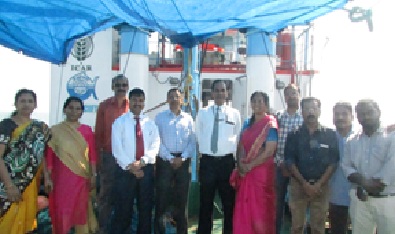 |
 |
| Fig. 1. FV Sagar Harita |
Fig.2. hydraulic winch on board F.V. Sagar Harita |
Modern mechanized fishing in India is highly energy-intensive, consuming vast amount of fossil fuels and contributing significantly to carbon emissions. To address these challenges, ICAR-CIFT launched the project Green Fishing Systems for Tropical Seas (GFSTS), funded by the ICAR-NASF, with the goal of developing a new generation of energy-efficient fishing vessels. A nationwide survey of fishing harbours and boatyards provided data on existing vessel designs, which were analyzed for stability and hull geometry to develop the new design. The development of a new generation energy-efficient combination fishing vessel under the ICAR-CIFT initiative represents a significant advancement in sustainable fisheries. Using parent ship designs, a 19.75 m hull form was developed with Autoship and Maxsurf software, and its resistance characteristics were validated through Computational Fluid Dynamics (CFD) simulations. Model testing and stability analysis at IIT Madras, following ITTC recommendations, enabled optimization of the design. Incorporating refrigerated storage systems improved fish quality, enhanced market value, and ensured better products for consumers. Furthermore, adherence to standardized construction practices extended vessel lifespan and reduced maintenance requirements. The resulting vessel F.V. Sagar Harita constructed by Goa Shipyard Limited under the classification of the Indian Register of Shipping, equipped for deep sea long lining and gillnetting, serves as a standard commercial prototype for replication in the tropical waters aiming to reduce the carbon footprint of India’s fishing sector while improving operational efficiency. Field trials demonstrated 5% fuel savings compared to similar vessels, validating the efficiency of the design. Following these successes, ICAR-CIFT was entrusted with preparing technical specifications for 22–23 m vessels under the national Blue Revolution and PMMSY schemes of the Govt. of India.
Novel features and advantages of the 19.75 m F.V Sagar Harita
|
Novel features
|
Advantages
|
|
Bulbous bow
|
To minimize wave resistance and improve speed
|
|
RSW tank (0 ºC to -1 ºC)
|
High quality storage of fish
|
|
Solar panels
|
For navigational and cabin lights without fossil fuel consumption
|
|
Hydraulic long line winch, Split trawl winch and Gillnet designed by ICAR- CIFT
|
Efficient long line handling and reduces human effort. Better opening and easy handling of trawl, Hauling longer deep-sea gillnet fishing
|
|
Freezer-cold store-RSW tank in a row
|
Efficient handling of fish
|
|
Reduced wheelhouse height
|
Reduces the draft and displacement results in fuel saving and better stability of vessel
|
|
Efficient propulsion system utlising results of CFD analysis and towing tank model testing
|
Saves fuel on overall operations of this vessel by 5%
|
|
Nozzle propulsion
|
Increased thrust and maneuverability and energy efficiency during fishing
|
 |
 |
|
Hon. DG Dr.Trilochan Mohapatra and DDG, Dr.J. K Jena of ICAR onboard F.V. Sagar Harita
|
Director of ICAR-CIFT and CMD Cochin Shipyard after signing of MoA for the design of Long liner cum Gillnetter. |
ICAR–CIFT and Cochin Shipyard Limited developed and deployed 918 deep-sea longliner-cum-gillnetter vessels between 2017 and 2024 under the Blue Revolution and PMMSY schemes, with a total investment of ₹867 crore. This large-scale initiative significantly was the first major step in India’s deep-sea fishing sector, strengthening offshore fishing capacity, and reduced pressure on coastal fish stocks.









